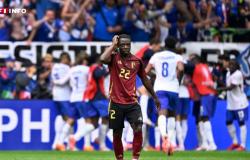
While the Olympic flame will arrive in Lille on July 2nd, welcomed by a huge parade of more than 1,800 people and 65 sports associations from the city, and then travel to Ohlain on July 3rd, many events around sport and the Olympic and Paralympic Games are to be discovered this weekend in Nord-Pas-De-Calais. Zoom in on two of them.
“Pas-de-Calais, land of sports”, the history of the Games deserves an exhibition !
From this weekend until September 30, the history of games is exhibited on nine sites in Pas-de-Calais, Neufchâtel-Hardelot, Camiers-Sainte-Cécile, Berck-sur-Mer, Arques, Aire-sur-la-Lys, Auxi-le-Château, Noeux-les-Mines , Rouvroy and the Ohlain Departmental Park which will host the Olympic Flame on Wednesday July 3.
Outdoor exhibitions, dedicated to the history of sport and Olympism in Pas-de-Calais and organized around eight themes.
Eight themes to draw up a history of sport from the 1900s to the present day, and address the Olympics and the specificities specific to our department.
Conducted in partnership with three teachers from the University of Artois: Olivier Chovaux, Noémie Beltramo and Jean Bréhon, Pas-de-Calais, land of sports thus traces the establishment of modern sports in the department since the end of the 19th century, with regard to the successive Olympics since the “reestablishment” of the Games – in particular those having taken place in France, the “international physical exercise competitions” of the Universal Exhibition of 1900, the Summer Games in Paris in 1924 or the winter editions of Grenoble (1968) and Albertville (1992).
Ohlain Park will be covered by the torch relay.
•
© DR
Competitions that also reflect the evolution of practices and sporting spectacle. If English sports arrived very early in the coastal towns of Pas-de-Calais, they spread just as quickly in the interwar period: accessible to the greatest number, the disciplines used during the Olympic Games also bear witness to the changes in body techniques and the modes of engagement of athletes, men or women, able-bodied or disabled.
Pas-de-Calais, land of sports also addresses more thematic aspects, around the great figures of French sport, Pierre de Coubertin and Alice Milliat in particular, or even the medal-winning athletes in the spotlight.
The exhibition also recalls the political, economic and geopolitical dimensions of the Olympic Games: places for reading international relations, a means of affirming the vitality of a State (independently of its political regime), these are also tools at the service the development of territories, like the Pas-de-Calais Department, “rear base” for the London Games in 2012, and the numerous sports infrastructures built on this occasion.
With this journey through the history of the Games and sports, the exhibition bears witness to the vitality of a philosophy and values born more than a century ago, and which the Paris 2024 Games, despite a difficult context, will be responsible for embodying.
“Wounded soldier, sports soldier: the journey of reconstruction”
In Fromelles, the Battle Museum invites you to discover another part of the history of sport this weekend.
This museum, a memorial to the battles between German, Australian and British soldiers in July 1916, presents a new exhibition on the history of war wounded who rebuild their lives through sport.
“Wounded soldier, sports soldier: itinerary of reconstruction”, honors these wounded or mutilated in war, who have rebuilt themselves but also reintegrated through sporting practice. The First World War left a lasting mark on the bodies and minds of soldiers. Crippled, damaged bodies, which require re-education, reconstruction and reintegration into a world which is also rebuilding itself.
As Hélène Blanc, the director of the Museum, recalls, this reintegration through sport really began in 1919. « If the first organized aid took place during the Battle of Solferino, the view of repatriated war wounded would really change after the First World War. In 1919, Europe had 21 million mutilated or wounded men who had to be reintegrated and who rehabilitated themselves with sport.
Wounded soldier, sports soldier, itinerary of reconstruction.
•
© DR
A second life for these soldiers who were physically affected at the front and who would regain confidence through sport during the 20th and early 21st centuries.
Through rare documents, photos, films, but also prostheses, the exhibition shows how these men devoted to their country rebuilt themselves, and thereby demonstrates that sport, beyond medals, can also offer a magnificent resurrection.
In France, many institutions will play an important role in the care and reconstruction of war victims.
You will discover the first rehabilitation centres, such as in Vizille in the Alps in 1917 and 1918, but also how the Grand Palais in Paris (future Olympic site) was transformed at the time into a military hospital to allow soldiers to practice a sporting activity.
Eugene Criqui
•
© France Télévisions
Physical and sporting activities also appear to be decisive tools in the rehabilitation of war wounded. This rehabilitation through sport was encouraged throughout the 20th century.
Sports associations and federations were set up. They structured and regulated these practices so that war wounded could play in the best conditions. Thus came the creation of the Amicale sportive des mutilés in 1954.. From the 1960s onwards, we witnessed an institutionalization and then a globalization of these sporting activities. Thus, the “handisport” identity emerged. In 2006, the National Defense Sports Center was created to generalize this type of rehabilitation.
The exhibition also takes us back to the first cycling Grand Prix in 1920, but also the first Paralympic Games in Rome in 1960 and the Invictus Games in 2014, a major publicized event which brought together hundreds of disabled soldiers and war veterans.
An evolution also made possible, thanks to the new techniques that the devices benefited from. During the First World War, new prostheses allowed these soldiers to find a social and professional life again. From wooden and iron prostheses, we will move at the beginning of the 2000s to carbon body extensions allowing these “new athletes” to be efficient.
Wounded, mutilated, through perseverance, these soldiers experienced a real rebirth thanks to sport, to the point of becoming real idols. Through sport, these soldiers will become the first athletes in sports competitions.
This is the example of Eugène Criqui, a Parisian boxer nicknamed “Gégène, the Broken Mouth”, because he was seriously injured in the face during the Battle of Epargnes in 1915, requiring the installation of metal plates in place of his jaw, earning him to be presented as “the boxer with the iron jaw”. He will be European champion in 1922 and world featherweight champion in 1923, the second Frenchman after Georges Carpentier to win such a title.
Another example, Joseph Guillemot, this athlete had partially lost the use of his lungs after being gassed in 1915. This middle-distance runner would become Olympic champion in Antwerp in 1920 over 5000 meters.
And then, there is also Armand Massard, fencer, injured in the stomach in 1914, who won three medals including a gold in epee at the Antwerp Games, and later became president of the French Fencing Federation and vice-president of the IOC.
Labeled “Cultural Olympics” and organized in collaboration with the UREPSSS, “Sport, Health, Society” Research Unit – “Strategy of Sports Organizations” Group, of the University of Lille, this exhibition highlights these advances which make these increasingly powerful athletes, and the journey of these athletes who shed light on this new story.
Museum of the Battle of Fromelles On view until February 2, 2025. Free admission.





